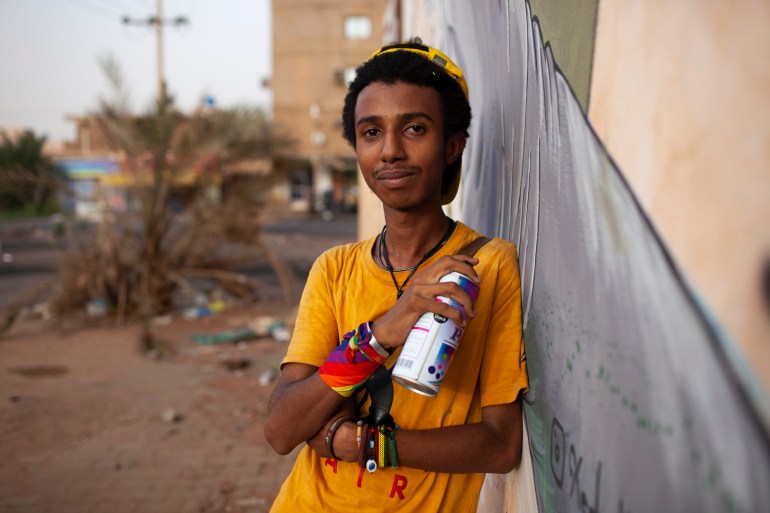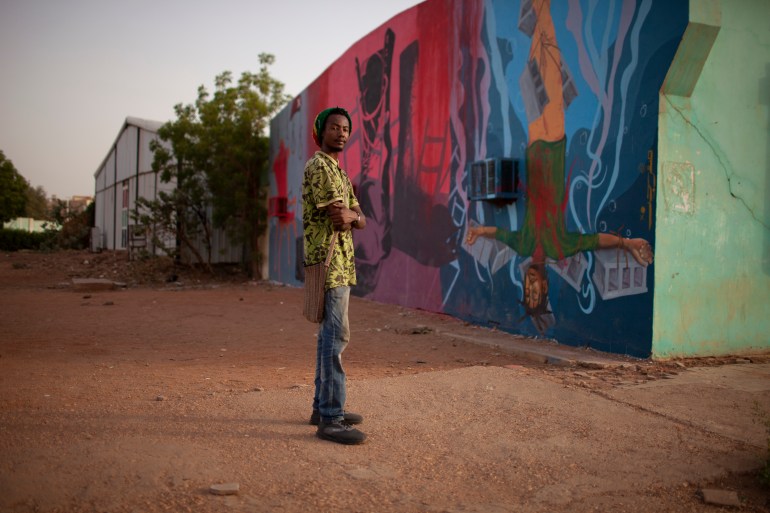Reporting for this article was supported by a grant from The Pulitzer Center.
Khartoum, Sudan – On the exterior wall of Khartoum’s morgue, a peach-coloured building attached to a hospital, a spray-painted corpse-hand with green fingernails emerges from the ground. On one of the fingers is a tag with the word “missing” – a reminder of the 200 bodies that remain inside, most of them unidentified protesters shot during the 2019 revolution. The whiff of decomposing bodies lingers on the street, the result of persistent power cuts which cause the refrigerators inside to turn off daily. Next to the painting of the hand, the word “anger” is written in Arabic.
Recommended Stories
list of 4 items- list 1 of 4A journey through Sudan’s golden era of music
- list 2 of 412 defining moments in Sudan’s 12-month uprising
- list 3 of 4The art of revolution: What went right in Sudan and Algeria
- list 4 of 4Sudan cinema: Reviving a forgotten art
The mural is just one of hundreds that have emerged on walls across Sudan’s capital in the two years since the revolution. Most depict martyrs, politicians, Nubian queens, and the crimes of the former regime of Omar al-Bashir.
What started out as protests against rising food and fuel costs in December 2018, turned into a coup d’etat by April 2019. The eight-month-long protests included sit-ins, boycotts, a “millions march”, and the removal of al-Bashir after 30 years in power. Sudan then saw the establishment of a joint civilian and military government, known as the Sovereign Council, to lead a 39-month transition to democracy.
Throughout the revolution, and since, artists have helped capture the dissatisfaction of ordinary people. During the months-long sit-in of an estimated two million people at the military headquarters in Khartoum, they painted murals, distributed fliers and organised chants, until the sit-in was violently dispersed by paramilitary forces on June 3, 2019, and more than 100 civilians were killed.
Weeks later, on June 30 – an historically significant day that marked the anniversary of the start of al-Bashir’s regime – protesters took to the streets demanding civilian rule and accountability for the June 3 attacks. Now, two years on, the artists who propelled the uprising by using their work to garner international attention, are once again at the forefront of political activism in the country, frustrated by a lack of justice for those killed, and the religious influence on parts of the government.

Moving from subculture to mainstream
Behind a multi-coloured brick building in Khartoum’s Al Zohur neighbourhood, a residential area close to one of the city’s cemeteries, is the Civic Lab. The space was founded by a group of creatives, including filmmaker Hajooj Kuka, 45, and curator Duaa Tarig Ahmed, 28. After the events of 2019, they thought it necessary to provide a space for Sudan’s underground art scene, which had exploded.
“We needed to keep the spirit of the sit-ins alive,” says Kuka, sitting under a whirling fan.
The lab is an old, two-storey house with little furniture. At the entrance, a group of hip-hop artists smoke cigarettes as they spit rhymes. Inside, activists share political poetry in a blacked-out, air conditioned recording studio so as to escape the scorching heat. In the back yard, a group of graffiti artists laughs at TikTok videos. Kuka and Ahmed meander through the rooms and give advice to each group, as the glue that brings everyone together.

“We want to move from the subculture into the mainstream,” she says, running a hand through her short, curly hair which she stopped covering after the public order law that governed how women dressed was repealed after the revolution in November 2019.
It was during the revolution that the Sudanese public learned to appreciate the power of art and discovered the artistic talent in the country, says Kuka, who was based in Kenya before the protests began. But while the perception of art has changed in the country, and personal freedoms have improved – such as women being allowed to choose how to dress – the Lab continues to be harassed by those with a strict interpretation of Islamic rules, as it is a place where unmarried women and men can socialise freely.
In October 2020, Kuka, Ahmed and nine others were arrested and imprisoned for two months on charges of public nuisance after partaking in a mixed-gender theatre workshop that used experimental dance to depict the 2019 crackdown by security forces. During their two-week imprisonment, fellow artists staged street sit-ins and used social media to draw attention to the country’s “state of artistic emergency”. Eventually, they garnered the attention of global film festivals and Human Rights Watch, which put pressure on the authorities to release them.

“That is why it is so important to have the Civic Lab, as artists can feel safety in numbers,” he says. “We can’t deny that there’s a difference from the time of Bashir, but what the present government thinks is development is not what we think it is.”
Freedom, justice, peace
Graffiti artist Assil Diab agrees with Kuka. Diab, who tags as SudaLove, is renowned for the large faces of murdered protesters she paints on walls near their family homes. She says that of the three asks – freedom, justice and peace – only partial freedom has been achieved. Today, people’s basic needs are not being met; Sudan’s inflation is at more than 350 percent, fuel shortages last for days and there are constant power outages.

Diab, who was living in Qatar before the protests started, decided to move back to Sudan and use her skills as an artist to serve the revolution. Donning a pink gas mask and a technicolour bag full of spray cans, Diab paints murals around the city. At the start of the protests, people questioned her motives but today, whenever she paints, there is always a small crowd gathered around admiring her work.
By painting the murals, Diab knowingly puts herself in danger. Before the law on how women dressed in public was repealed, she worried that wearing baggy trousers would get her in trouble with the police. In one instance, a deceased protester’s family formed a human wall to protect her from security forces while she finished her work.
“It was a defiant show of strength,” she says, her eyes tearing up.

Makkawi, who chose a tortoise as the slogan for the centre because slow and steady brings justice, says he was extremely concerned by the arrest of Kuka and other members of the Civic Lab in October 2020, as he knows that the authorities fear art.
“The artists are the ones that continue injecting blood into the revolution,” Makkawi says holding his finger up in the air. “That is why on 3 June, the security forces not only killed protesters but wiped and painted over the murals.”
Makkawi hopes the guidance he has provided artists on navigating the country’s legal system will in turn be shared with the public in creative ways. “As lawyers we are very boring, art can tell the message of justice much better,” he says with conviction.
‘We have too much to lose’
On the top floor of a five-storey, sand-coloured, brick building, Elhassan Elmountasir creates black canvases with white text and green geometry. The abstract painter explored the fashion trend of camouflage after the revolution, which he says pointed to a display of Stockholm syndrome on the part of the public, who adopted the uniform of their oppressors. He says that issues facing the country are even blurrier now.

In May, one of the two civilian women appointed to the 14-member council resigned after Sudanese forces killed two demonstrators who were marking the second anniversary of the protests. Ayesha Musa Saeed accused military leaders of sidelining the council’s civilian members and purposely blocking development in the country.
Jonas Horner, a senior analyst for Sudan for the International Crisis Group, tells Al Jazeera that as Sudan’s historic transition stumbles forward, it is no secret that the military is seeking to secure its economic interests, while Bashir regime loyalists attempt to wrest back control.
“Were they to succeed, the newly won personal freedoms of women, journalists and artists could be reversed,” he says.
Following the “colourful revolution,” which saw cities across Sudan fill up with art, Elmountasir says that international collectors, galleries and funders turned their attention to Sudan. European foundations, such as the French Institute, began organising exhibitions in Khartoum, reflecting on the 2019 revolution.
“Before the overthrowing of the regime, that would not have been possible,” he says, looking down at his shoes with a smile. “The freedom to talk about everything; that feels good.”

On Monday, for the first time in Sudanese history, the Supreme Court found a member of the intelligence services guilty of crimes against humanity for shooting and killing medical student, Hassan Muhammad Omar, who was demonstrating in December 2018.
Aljeally says that this has given people renewed hope that the country will emerge from the transition united, as a democratic state.
“We have too much to lose now, not just artists but everyone,” she says. “We cannot go back.”

